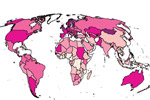Nearly a million people are in need of immediate food assistance in Somalia, where delayed rains, high food prices, and insecurity threaten a repeat of the 2011 famine that left 258,000 people dead. According to the UN’s Food Security and Nutrition Analysis Unit (FSNAU), 857,000 Somalis need immediate assistance while over 200,000 children under five in the country are currently suffering from acute malnourishment.
“The month of May remains critical during which, if rains fail, combined with sustained insecurity, we might see new levels of crisis unfold especially in southern parts of Somalia and the mainly pastoral northeast,” Daniel Molla, the Chief Technical Advisor of FSANU, said.
Rains in April were far below normal in the country’s north, which “has led to early depletion of fresh water sources for human and animal consumption,” according to a release from the FSNAU. “The two major rivers that support irrigated agriculture, the Juba and Shabelle, are currently below their normal levels for this time of the year and one meter lower compared to the levels of last year.”

A girl stands in front of freshly dug graves in Dadaab, Kenya. The town was one of the places Somali refuges fled to during the 2011 famine, but many didn’t make it. Most of the dead were children. Photo by: Andy Hall/Oxfam East Africa/Creative Commons 2.0.
The situation is also exacerbated by an increasing battle against al-Shabab insurgents, who have blocked trade into some areas where they’ve been pushed out by Somali government troops.
“For instance, the price of red sorghum increased by 25 percent, while the prices of other essential imported food (rice, wheat flour, sugar, vegetable oil) increased in the range of 40-50 percent during the month in Hudur market of Bakool region,” stated the FSNAU.
In 2011, similar factors—failed rains and insurgency—led to Somalia suffering the worst famine worldwide in 25 years. According to an in-depth report last year, 258,000 people died in this famine, more than half children under five. The report blamed the international community for reacting too late and doing too little to stop the mass death.
“The suffering played out like a drama without witnesses,” Philippe Lazzarini, UN Humanitarian Coordinator for Somalia, said last year, adding “we could have done more before famine was declared on 20 July 2011…warnings that began as far back as the drought in 2010 did not trigger sufficient early action. In the worst affected areas, access to people in need was tremendously difficult.”
Related articles

(03/31/2014) It’s not just melting glaciers and bizarrely-early Springs anymore; climate change is impacting every facet of human civilization from our ability to grow enough crops to our ability to get along with each other, according to a new 2,300-page report from the Intergovernmental Panel on Climate Change (IPCC). The massive report states definitively that climate change is already affecting human societies on every continent.
Dietary diversity: key to defending tropical ecosystems
(03/06/2014) A new study published in the Proceedings of the National Academy of
Sciences (PNAS) points to the homogenization of global diets over the past
fifty years. It shows that worldwide production of traditional staples
such as millet, rye, sorghum, yams and cassava have been in decline.
Instead, the world’s population increasingly relies on a relatively
small number of ‘megacrops’ like wheat, corn and soy, raising
serious concerns for global food security, human nutrition, and the
genetic diversity of crops.
20 million people face hunger in Africa’s Sahel region
(02/04/2014) The UN and partner humanitarian groups today called on the international community to spend $2 billion to avoid a famine in Africa’s Sahel region, which includes nine nations along the southern edge of the Sahara. Although the Sahel is chronically prone to food insecurity, the situation has dramatically worsened as the UN estimates 20 million people are at risk of hunger up from 11 million last year.
Humans are not apex predators, but meat-eating on the rise worldwide

(12/05/2013) A new paper in Proceedings of the National Academy of Sciences has measured the “trophic level” of human beings for the first time. Falling between 1 and 5.5, trophic levels refer to where species fit on the food chain. Apex predators like tigers and sharks are given a 5.5 on trophic scale since they survive almost entirely on consuming meat, while plants and phytoplankton, which make their own food, are at the bottom of the scale. Humans, according to the new paper, currently fall in the middle: 2.21. However, rising meat-eating in countries like China, India, and Brazil is pushing our trophic level higher with massive environmental impacts.
Climate change to hurt children most
(09/25/2013) Children will bear the brunt of the impact of climate change because of their increased risk of health problems, malnutrition and migration, according to a new study published on Monday. And food prices are likely to soar as a result of warming, undoing the progress made in combating world hunger.
Worst drought in 30 years threatens millions in southern Africa with food insecurity
(08/19/2013) Around 2 million people face food insecurity in northern Namibia and southern Angola as the worst regional drought in decades takes its toll, according to the UN. Two years of failed rains have pushed families into desperate conditions in a region already known for its desert-like conditions. In Namibia alone, experts estimate that over 100,000 children under five are at risk for acute malnutrition.
Crop yields no longer keeping up with population growth
(06/26/2013) If the world is to grow enough food for the projected global population in 2050, agricultural productivity will have to rise by at least 60%, and may need to more than double, according to researchers who have studied global crop yields.
Eat insects to mitigate deforestation and climate change

(05/14/2013) A new 200-page-report by the UN Food and Agriculture Organization (FAO) urges human society to utilize an often-ignored, protein-rich, and ubiquitous food source: insects. While many in the industrialized west might turn up their noses at the idea of eating insects, already around 2 billion people worldwide eat over 1,900 species of insect, according to the FAO. Expanding insect-eating, the authors argue, may be one way to combat rising food needs, environmental degradation, and climate change.
Nearly a million people face food crisis in Niger
(05/13/2013) Around 800,000 people in Niger face food insecurity in coming months, according to the UN’s Office for the Co-ordination of Humanitarian Affairs (OCHA). Rising food prices and refugees from Mali, which is plagued by conflict, have made access to food difficult in the west African country.
‘Suffering…without witnesses’: over a quarter of a million people perished in Somali famine

(05/06/2013) A new report estimates that 258,000 people died in 2011 during a famine in Somalia, the worst of such events in 25 years and a number at least double the highest estimations during the crisis. Over half of the victims, around 133,000, were children five and under. The report, by the UN Food and Agricultural Organization (FAO), argues that the international community reacted too late and too little to stem the mass starvation brought on by government instability, conflict, high food prices, and failed rains, the last of which has been linked to climate change by some scientists.